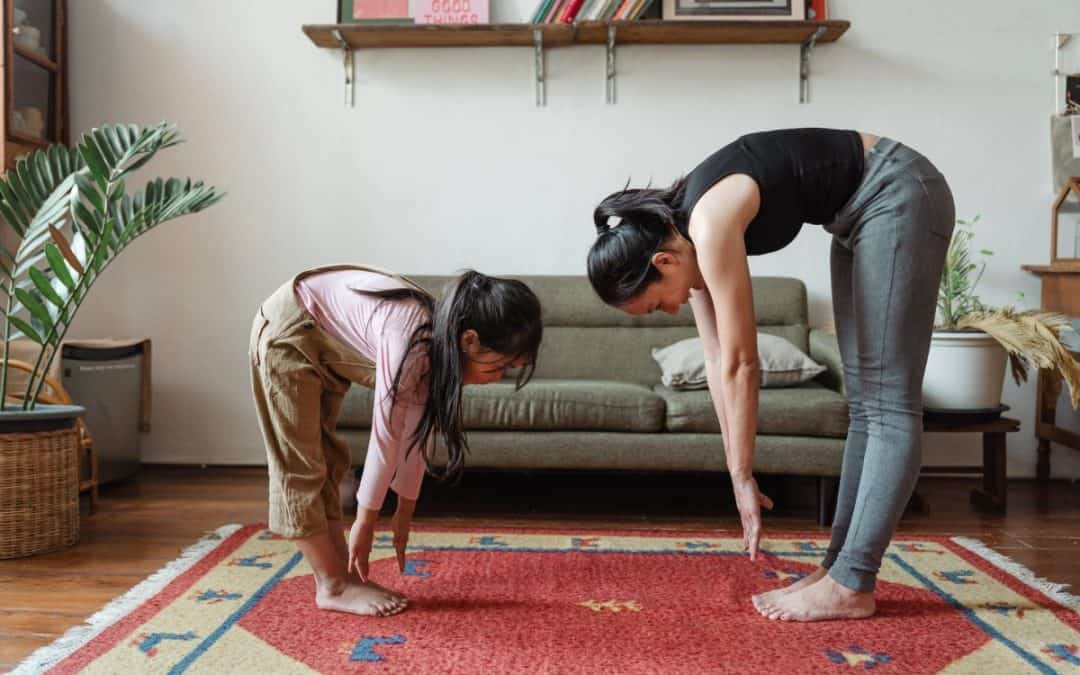While most children are born healthy and fit, not all of them remain that way. Doing so depends in great part on four factors: environment, attitude, knowledge, and lifestyle. All of these elements are within your control. In honor of National Physical Fitness & Sports Month (May), let’s look at them one at a time…
Environment
What does your child’s environment consist of When forced to stay indoors due to inclement weather, is his only choice to sit still somewhere? Or is there room for the two of you to put on a CD and dance? To play Twister? Or perhaps even twirl hula hoops around your waists and other body parts? Is there somewhere in the house where space for activity is valued more than the display of easily broken knickknacks?
What about the outdoor environment? Does it include open areas for running, jumping, rolling, and the like? Is there a tree or purchased equipment for safe climbing, hanging, and swinging? How about a sandbox so your toddler can dig and haul? Does your child have access to activity-oriented toys, like a tricycle or bicycle, balls, or ribbon sticks, like the ones the rhythmic gymnasts use?
Attitude
Setting up the environment for physical activity also falls under the heading of demonstrating a proper attitude, as does exhibiting enjoyment toward physical activity. Do you moan and groan when it’s “time” to put in the aerobics tape? Do you get off your bike or finish your walk huffing and puffing and making it seem like an ordeal? Or do you express enthusiasm as you lace up your sneakers or follow a brisk stroll? It’s OK if children understand that sometimes physical activity is an effort as long as they also understand that anything worth doing is worth some effort.
Most importantly, do you play with your child? There’s research showing that the influence of parents and siblings does indeed increase children’s physical activity levels. In fact, your actual participation in your child’s activities (especially if she’s in the under-seven set) will have much more effect on her activity levels than if you simply insist she is active.
Children learn by watching you. If you spend the majority of your free time in sedentary activities, like watching television, that’s what they’ll want to do, too. But if you spend your free time playing, not only will they have someone to play with, they’ll have a terrific role model. Because you have a playful, positive attitude toward physical activity, they’ll assume the same.
Knowledge
Knowledge comes into play when you help your child understand why you and he take part in physical activity – why it’s necessary (which will help ensure that a positive attitude toward fitness endures beyond childhood). Certainly, lecturing children on the topic isn’t likely to have much of an impact; you’ll make the greatest impression mostly by example. But you can also offer a well-placed word or two. For example, as you stretch out: “It’s important to stretch after exercising so your muscles don’t get all bunched up.” Or, to stimulate your child’s natural curiosity: “Wow –chasing bubbles really got my heart pumping. It’s healthy to do that sometimes. Is yours going faster, too?”
Your child should also know why you choose family activities like skating, swimming, and rollerblading (“It’s important to be active so we can be healthy”). And she should have a vote as you decide on the family’s adventures. Would she rather go for a walk or a bike ride? Would she prefer going to the playground to mess around on the equipment, or playing Frisbee in the park? Remember: Choice is a necessary ingredient in fostering intrinsic motivation.
Lifestyle
Finally, there’s a lifestyle. If your child is to derive the benefits of physical fitness, then physical activity must be habitual and lifelong. Moving should be as routine as brushing teeth and bathing.
Not surprisingly, if we’re to instill habits, early childhood is the best time to start. Most importantly, if physical activity is a habit of yours – and of your family’s – it will become a habit for your child. And it will be an easy one to keep if it’s associated with pleasure rather than pain.
A pleasant association is most likely to happen if you
* Choose individual and family activities that fit easily into your lifestyle. * Select activities that are within your physical capabilities and those of your family members. * Pace activities with fun, rather than heart rates, in mind. * Don’t worry about scheduling; consistency is important, but it’s okay to be flexible. * Encourage one another, pointing out what’s right about what you’re seeing. * Don’t insist a child do something she’s not comfortable with; you can always try again in several months. * Expose your child to a wide variety of physical experiences. Just as you wouldn’t feed your child only chicken and spinach, you shouldn’t limit activity choices. * Keep competition out of the equation. No good can come from comparing children.
The goal is to make physical activity a customary part of your child’s – and your – life. However you choose to encourage the physical activity habit, you can be assured that if it’s introduced early in life, your child won’t be among those who struggle to remain fit.
Rae Pica is a children’s movement specialist and the author of Your Active Child: How to Boost Physical, Emotional, and Cognitive Development through Age-Appropriate Activity (McGraw-Hill, 2003). Rae speaks to parents and education groups throughout North America.








